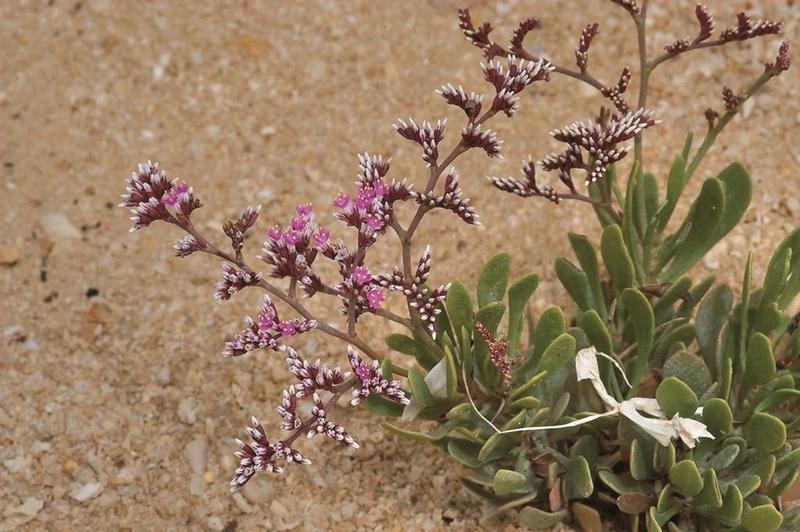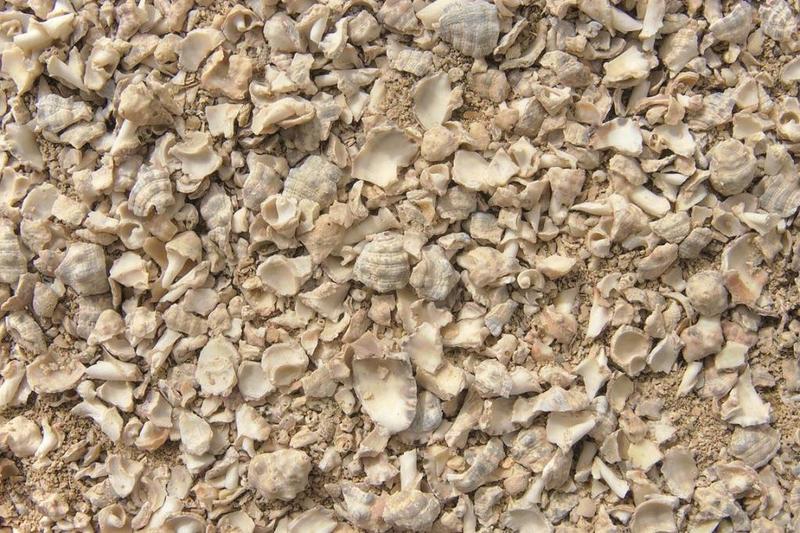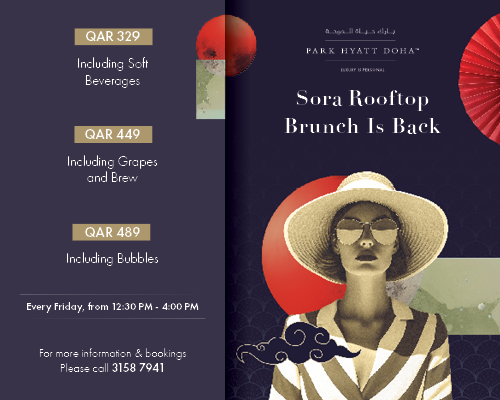Jazirat Bin Ghannam, generally known in English as Purple Island, is joined to the mainland by a shallow causeway which, although broken in two places, provides easy access.
Perhaps its most famous inhabitant was a species of small marine snail that made it a centre for a particularly valuable commodity over 3,500 years ago – the dye known elsewhere as Tyrian purple. Large-scale production at the ancient city of Tyre, in what is now Lebanon, gave the colour its name and at present Purple Island is the only known site for its manufacture in the Gulf.

The colour was derived exclusively from marine snails of the Muricidae and Thaisidae families. It is believed that it took some 12,000 crushed snails to extract 1.5 grams of the pure dye. Middens of shattered shells containing the remains of 3,000,000 snails, as well as remnants of large vats used in the dye production, indicate a thriving trade. Coarse Kassite pottery found on the island shows that the likely purchasers, or even producers, were the Kassite rulers of Babylonia where scarlet and purple-dyed cloth was much used as a prerogative of power by immediate members of the royal family and important religious figures.
Just as the very existence of the colour purple is open to debate since it’s not part of the natural spectrum, so the actual shade the dye produced is as elusive as the process that produced it. Purple in English comes from the Latin purpura, the term for the purple Murex dye, which comes from the even older Greek term for the snails the dye was made from.

Because the process for producing dye this way was lost after the conquest of Constantinople in 1453, there was much speculation as to the precise nature of the actual colour achieved. There are many variables in the process, including different hues produced by the various types of snails and the effects of sunlight. Proposed tints range from violet to deep red and brownish red. Pliny the Elder thought the best Tyrian purple was, the colour of clotted blood, dark by reflected, and brilliant by transmitted, light.
Mangroves
Qatar’s sun-baked landscape is dominated by flat, unconstrained space and the occasional rock formation or tree seems almost an aberration. However, on Purple Island in the almost enclosed bay of Al Khor, where salt has been added to the equation, a surprising number of trees and animals make their home.
The main vegetation of the island and the surrounding area is the mangrove trees. Qatar has one species, Avicennia marina or the Grey Mangrove, known as gurm in Arabic, living right at the northern limit of its range.
Mangroves are able to survive inundation by salt water twice a day, and in ‘soil’ which is unstable and poor in oxygen. To deal with salt, all mangrove trees exclude some salt at the root level, and all can tolerate more salt in their tissues than normal plants. Avicennia is one of the few mangroves that can tolerate high levels of salt in its tissues and its sap can be up to one-tenth as salty as seawater. Mangroves secrete the excess salt through special cells on their leaves. They are often the only trees to survive in hot salty regions.
Mangrove roots not only provide support in unstable soils but also breathe air. Avicennias develop shallow cable roots which spread out from the trunk. Along these cable roots emerge short pencil-like roots called pneumatophores (meaning ‘air carrier’ in Greek). On their surface special pores (lenticels) take in air excluding water and salts. A three-metre tall Avicennia can have 10,000 pneumatophores. All aerial roots also contain large air spaces (aerenchyma). These not only transport air, but also provide a reservoir of air during high tide when all the roots may be underwater. Roots for absorbing nutrients are tiny and emerge near the muddy surface.

Fresh water is as precious to a mangrove tree as to a desert plant since they have to expend energy to get rid of the salt in every drop of water they use. Thus, mangroves have many of the water conserving features of desert plants and, to minimise water loss through evaporation, Avicennia has thick waxy leaves. Fallen leaves are an important source of nutrients. They are rapidly broken up by small black crabs and other creatures, and further broken down by micro-organisms into useful minerals. There are even tiny moth larvae that feed on pneumatophores. The growing seed does not break through the fruit wall while the seed is on the mother plant, but only after the fruit falls off, when the seed coat drops away more quickly in water of optimum warmth and salinity. On a smaller scale halophytes, which tolerate salinity in water and soil, include Sea Lavender (Qetaif, Limonium axillare) with its delicate mauve and pink flowers and water-retaining leaves, and Al Keriza (Halopeplis perfoliata).
Getting There
Many people tell us they have enjoyed a trip to Al Khor. The town is worth a visit in itself – like a weekend seaside resort – but while you are there you could also take the time to explore one of the most interesting places in Qatar, one with real history, a real story to tell.
It’s really easy and you don’t need a four-wheel drive for this sector, but be careful not to go too deep into the mangroves!
Copyright © Marhaba Information Guide. Reproduction of material from Marhaba Information Guide’s book or website without written permission is strictly prohibited. Using Marhaba Information Guide’s material without authorisation constitutes plagiarism as well as copyright infringement.







